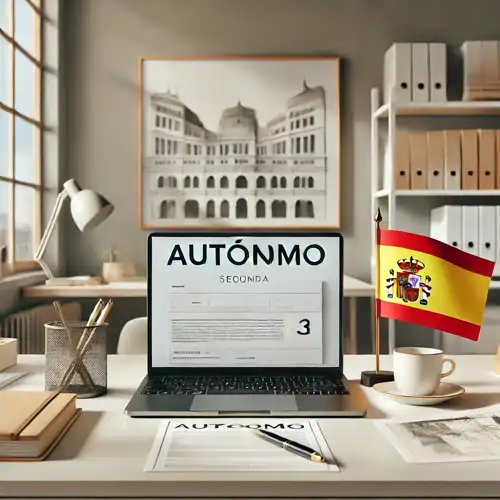In 2024, Spain has an updated registration and taxation system for sole traders (autónomo). Many people find this process complex and full of pitfalls. However, by understanding the key steps and requirements, you can avoid major problems and organize your business legally. Below, we'll break down why sole trader registration is necessary, what documents are needed, and how to proceed at each stage.
Problems and solutions when registering as an autónomo
Beginner entrepreneurs often face the following pain points:
- Lack of understanding of the sequence of actions: where to register first and what forms to fill out.
- Difficulties in choosing the tax regime and the contribution rate to the social security system.
- Uncertainty about when full registration is required and when a one-time tax payment is sufficient.
- Concerns about high monthly payments, especially at the start of activity.
The main solutions consist of a thorough study of the requirements and strict compliance with formalities. It is important to know the main abbreviations and their meanings, as well as to take advantage of the reduced rate (tarifa plana) in the first months of operation.
Step 1. Obtain the NIE (Número de Identificación de Extranjero)
The NIE (Número de Identificación de Extranjero) is the identification number for foreigners. Without it, it is impossible to carry out official economic activities in Spain. The NIE can be obtained at the Spanish police or at the Spanish consulate abroad. To obtain it, you will need:
- Valid passport or DNI (Documento Nacional de Identidad) for EU citizens.
- Completed standard application form.
- Documents proving the place of residence or the reason for staying in Spain.
- Payment of a small fee.
Step 2. Register with the Tax Agency (Agencia Tributaria)
After obtaining the NIE, you must notify the Tax Agency of your intention to work as an autónomo. To do this, you must fill in at the Agencia Tributaria:
- Form 036 or 037: Form 037 is shorter and is usually suitable for freelancers. Form 036 is used if additional registration is needed (for example, to work with clients in other EU countries).
- Selection of the corresponding IAE (Impuesto de Actividades Económicas) heading: a code that reflects the type of activity, from consulting services to trade.
It is necessary to correctly define the IAE heading, since the tax regime and the need to issue invoices with VAT depend on it.
Step 3. Registration with Social Security (Seguridad Social)
Within 30 days of registering with the Tax Agency, it is important to register with Social Security under the RETA (Régimen Especial de Trabajadores Autónomos) scheme. The main actions are:
- Fill in form TA.0521 and indicate the expected level of net income.
- Choose the contribution base: the amount of monthly payments and future benefits depends on it.
- Pay the first contribution. For 2024, there is a flat rate (tarifa plana) of 80 euros per month for new autónomos. After 12 months, the amount may vary depending on income.
To calculate your income level, take into account expenses, the amount of annual contributions, and the additional deduction, which is usually 3-7% (depending on the status of the entrepreneur).
Step 4. Bank and electronic certificates
Separate bank account
It is not mandatory, but it is recommended to open a separate bank account for business activity. This makes it easier to separate personal transactions from business ones, and it is also more convenient to keep track of accounting.
Digital certificate
To interact with the Tax Agency online, it is necessary to obtain a digital certificate. This certificate will allow you to file returns, pay taxes and check the status of your contributions without having to visit the offices. You can obtain it through the official website of the corresponding body or in person at one of the authorized offices.
Step 5. Relevant changes in 2024
From 2024, autónomo contributions are increasingly dependent on their actual net income. The amounts of the contributions are divided into 15 brackets. If the income is less than the Minimum Interprofessional Wage, the right to benefits, including the extended tarifa plana, is maintained.
The autónomo can adjust their base up to 6 times a year, modifying the amount of their monthly contributions. At the end of the year, the system will be adjusted: if the total income is higher or lower than declared, the difference will have to be paid or, conversely, the excess paid will be returned.
When registration is not mandatory
If the activity is sporadic and the income is below the established minimum (usually the Minimum Interprofessional Wage in Spain is taken as a reference), the payment of one-time taxes is allowed instead of full registration in the RETA. However, the criteria of "sporadic" are not strictly defined, which creates risks of fines. In each specific situation, it is better to consult with a tax advisor.
Taxes and reporting
The main obligations for autónomos in Spain are:
- VAT (Value Added Tax): standard rate of 21% on goods and services provided. Submitted quarterly.
- Income Tax (IRPF): paid partially during the year through form 130 or withheld from each invoice (retención). Final settlement in the annual income tax return.
- Monthly Social Security contributions: calculated on the chosen base taking into account actual income.
Payment and declarations are usually quarterly. Failure to file returns or delays lead to fines.
Hiring employees or subcontractors
If at some point the business expands, you can hire employees. In this case, you must open a work center at the Labor Inspectorate and register each employee with their own contributions and contract. Alternatively, you can collaborate with other professionals as subcontractors, if they are themselves registered as autónomos or have a legal entity.
Temporary and seasonal work
Often, entrepreneurs face the seasonality of their activity. In this case, they can use the right to register and deregister up to three times a year. However, keep in mind that if you are already enjoying the tarifa plana, a new registration may cause you to lose this benefit. Always compare the potential risks and benefits.
Liability and penalties
In Spain, the entrepreneur has unlimited liability for debts and obligations, if they do not have a legal entity incorporated as an SL (Sociedad Limitada). In addition, failure to pay contributions or taxes leads to fines. The amount of the penalties depends on the duration of the delay and the amount of the debt.
Conclusion
Registering as a sole trader (autónomo) in Spain in 2024 requires understanding the steps and paying attention to the submission of documents. Despite the numerous formalities, proper registration gives the entrepreneur full rights and social guarantees. It is important to:
- Obtain the NIE (Número de Identificación de Extranjero) in advance.
- Register on time with the Tax Agency using form 036 or 037.
- Register with Social Security and monitor the correctness of contributions.
- Keep track of income and expenses, and file VAT and IRPF returns on time.
Compliance with these rules will help avoid fines, reduce financial risks and allow you to focus on developing your business.








